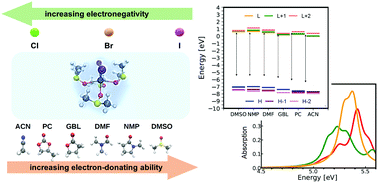First-principles analysis of the optical properties of lead halide perovskite solution precursors†
Abstract
Lead halide perovskites (LHPs) are promising materials for opto-electronics and photovoltaics, thanks to favorable characteristics and low manufacturing costs enabled by solution processing. In light of this, it is crucial to assess the impact of solvent–solute interactions on the electronic and optical properties of LHPs and of their solution precursors. In a first-principles work based on time-dependent density-functional theory coupled with the polarizable continuum model, we investigate the electronic and optical properties of a set of charge-neutral compounds with chemical formula, PbX2(Sol)4, where X = Cl, Br, and I, and Sol are the six common solvents. We find that single-particle energies and optical gaps depend on the halogen species as well as on the solvent molecules, which also affect the energy and the spatial distribution of the molecular orbitals, thereby impacting on the excitations. We clarify that dark states at the absorption onset are promoted by electron-withdrawing solvents, and we show the correlation between oscillator strength and HOMO → LUMO contribution to the excitations. Our results provide microscopic insight into the electronic and optical properties of LHP solution precursors, complementing ongoing experimental research on these systems and on their evolution to photovoltaic thin films.



 Please wait while we load your content...
Please wait while we load your content...